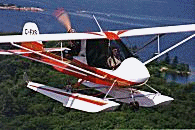|
The information contained in this document is intended for the sole use of Canadian Challenger owners and is strictly proprietary and confidential. A good covering job is not difficult to accomplish on your first try, however it does require patience and time. Small details make the difference. Make sure the seams on the pre-sewn fabric envelopes are straight with the excess material beyond the sewn line folded uniformly on one side only. Otherwise it will be lumpy. Make sure your finishing tapes are straight, parallel where necessary (like on the wing ribs), and properly laid down. Lifted finishing tape edges can spoil the appearance of an otherwise perfectly finished airplane. A few tips may help. Calibrate your iron to determine the true temperatures it actually delivers. Shrink the fabric with a first pass at 300 degrees, then a second pass at 350 degrees. Detailed instructions are available in the Polyfiber 'How to Cover an Aircraft' manual. Stits also produce a video on covering which explains the process in great detail. It is important to know that any fabric that will be in contact with tubing directly or due to vibration or air pressure, but is not glued to it, should be protected with a strip of tape to prevent chafing. As the airplane ages, the aluminum tubing will naturally oxidize and that roughness will eventually chafe through the fabric. This includes the lower curved formers under the engine, and the underside of the compression and drag struts in the wings. These tubes should be taped before covering using white cloth tape (available at hardware stores). As well, it is mandatory on Stits or Superflite covered wings that the aileron gap be sealed. While this can be done with tape after doping is complete, it is preferable that it be sealed with 2 inch finishing tape during the covering process so that it can be painted with the wing. The tape should run down the trailing edge spar to the hinge line then across and up the aileron leading edge. While not mandatory, a small performance gain can be achieved by sealing the gaps between the dorsal fin and fuselage, stabilizer and elevator, fin and rudder and the fin and longeron tubes. An alternative to simply using finishing tape is a piece of foam weather stripping that is thicker than half the gap glued along each of the parts (ie; the trailing edge of the stab and leading edge of the elevator). Covered with finishing tape and painted, they butt together to provide a neat yet de-riggable gap seal.
To learn and see more order our comprehensive information package and video! |

